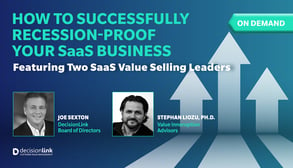The Challenges with Technology and Change Management

I have been involved in value and pricing management activities for over 15 years. At the beginning of my work in the field, I quickly realized in order to succeed, we need to have strong change management and leadership programs. In 2012, I decided to become certified in change management and I joined a cohort of Prosci® certified experts.
Why is this so important? Well, we all know the following statistics:
- 70% of all projects fail.
- Over 70% of new product introductions fail.
- 70% of technology deployment initiatives do not reach the desired outcomes.
There seems to be a consistency of the 70% mark across the board. This happens for multiple reasons and scholars have researched this problem of practice for the past decades.
So why are technology projects and initiatives not reaching their desired outcomes?
Here are five key reasons:
- New technology was poorly integrated with the business’ objectives and not properly supported by an Executive Champion. Technology for technology's sake does not work. Technology that supports a business’ strategic objectives are better positioned for success. And without top-down support, re-iteration of project goals and importance, people will revert back to old habits, abandoning your efforts.
- The project was poorly run overall, and as a result, it fell through. Many organizations lack project management and execution excellence. We often see confusion between ‘project management’ and ‘change management’. They are not the same things and require different focus and skill sets. Failure to focus on either side of the coin will impede success.
- Companies don’t invest enough in enablement, adoption and usage. While it shouldn’t be a metric for overall program success (the business outcomes the project drives is what ultimately matters), ensuring you are spending time training users is critical. If they don’t know how to use it, they won’t see the value. Alternatively, the new technology could be so complex that users are discouraged from the get-go.
- Training programs don’t prepare users for the new environment and the transition between the old and new ways of working. Training programs must have a combination of learning and doing. They must give a safe space to users to experiment and see how the new technology helps them in their working experience and in their ability to achieve success.
- Technology vendors did not have a focus on adoption and support. Oftentimes, customers are left to do onboarding, user training, and adoption management on their own. It is, therefore, essential for customers to ask the right questions during the qualification and selection process about the ongoing training, support, continued learning and certification programs that a vendor offers.
There is no doubt that good change management and leadership makes or breaks a new technology or software deployment. In past blogs, we have reported that the average SaaS company deploys an average of 250 SaaS apps just in sales and marketing. The results of so many software solutions mean that users have to make sacrifices on where they spend their time. They will naturally spend more time in software and with technology that is simple, easier to learn, have influence in their daily life, and fully integrate in other applications. This is why the average adoption rate of new software is under 50%.
In the next blog of this series, we will go deeper into the topic of dashboarding, tracking KPIs, and what adoption is all about.


Read this whitepaper for 10 more strategies to Watch this webinar to learn how to avoid
strengthen your change management among the tech stack chopping block during the
your technology. economic downturn.
Author Bio

Dr. Stephan Liozu (www.stephanliozu.com) is the Founder of Value Innoruption Advisors (www.valueinnoruption.com), a consulting boutique specializing in industrial pricing, digital business, and value models, and value-based pricing. Stephan has 30 years of experience in the industrial and manufacturing sectors with companies like Owens Corning, Saint-Gobain, Freudenberg, and Thales. He holds a Ph.D. In Management from Case Western Reserve University, and has written several books, including Dollarizing Differentiation Value (2016) and Value Mindset (2017).

 ValueCloud
ValueCloud
.png?width=118&height=76&name=Rectangle%20(3).png) ValueCloud Ignite
ValueCloud Ignite
.png?width=92&height=92&name=Rectangle%20(4).png) Free Assessment
Free Assessment
.png?width=100&height=100&name=Rectangle%20(5).png) Watch a Demo
Watch a Demo
.png?width=82&height=96&name=Rectangle%20(6).png) Value Calculator
Value Calculator

.png?width=62&height=51&name=Group%2010%20(1).png) Marketing
Marketing
 Sales
Sales
 Customer Success
Customer Success
 Engage Prospects
Engage Prospects
 Win Deals Faster
Win Deals Faster
 Retain Customers
Retain Customers
.png?width=62&height=62&name=Rectangle%20(8).png) Adopt and Scale
Adopt and Scale
.png?width=54&height=54&name=Rectangle%20(9).png) Cybersecurity
Cybersecurity
 Healthcare
Healthcare
.png?width=54&height=54&name=Rectangle%20(10).png) IT & Software
IT & Software



